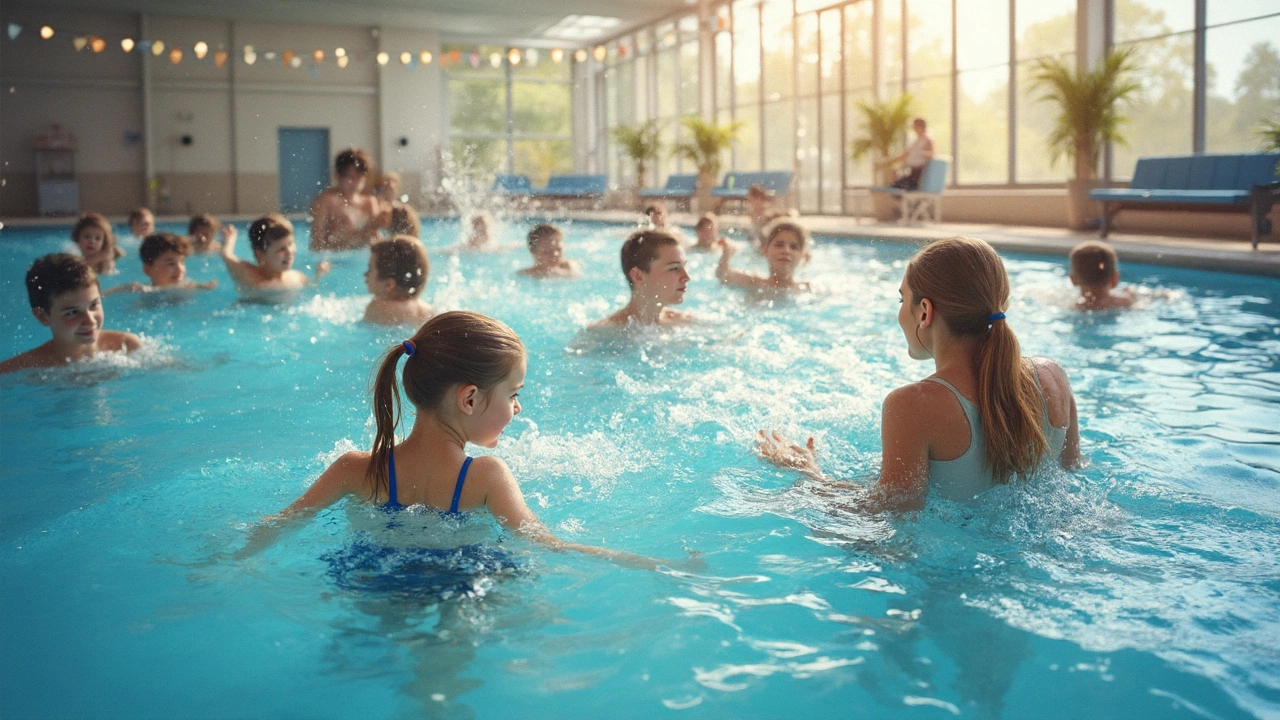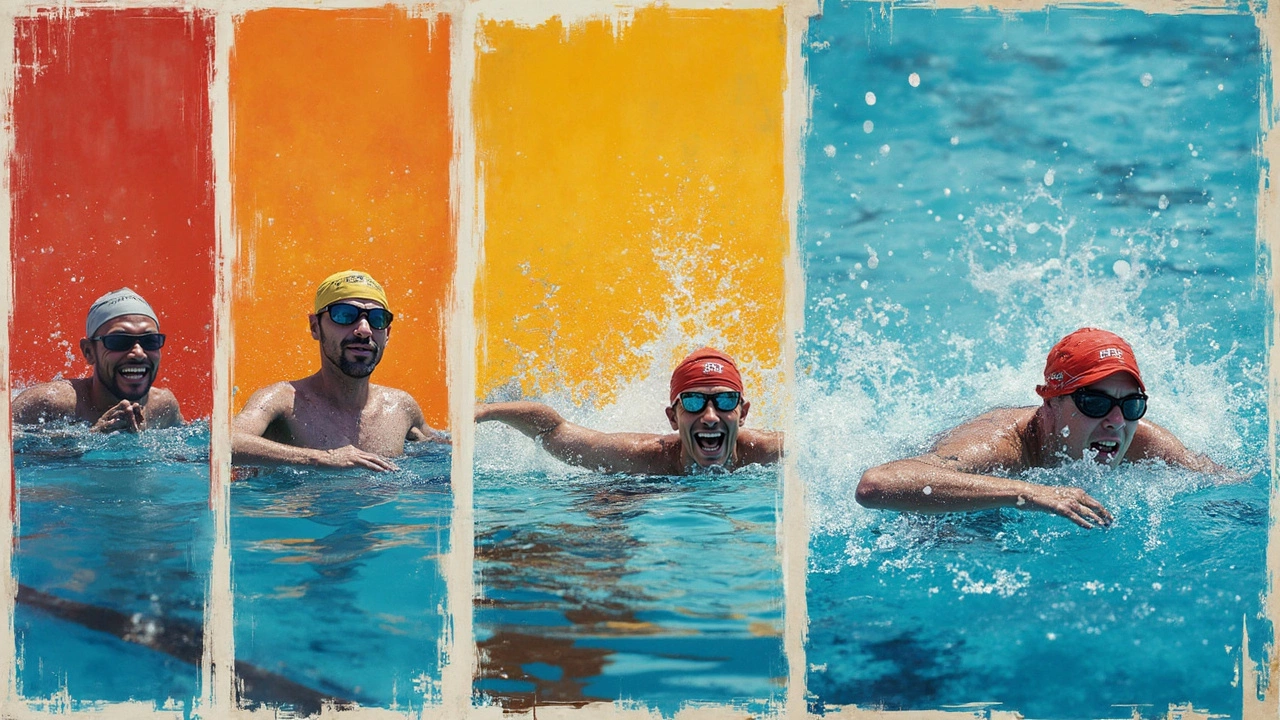How Many Days a Week Should You Learn to Swim?
 Mar, 25 2025
Mar, 25 2025
Ever thought about how often you should be learning to swim each week? You're definitely not alone. Finding the perfect balance between practice and rest is crucial, especially if you're just starting out. Swimming, like any skill, improves with repetition, but overdoing it can lead to burnout or even injury.
Most beginners find that swimming two to three times a week is the sweet spot. This frequency allows you to practice new skills without feeling overwhelmed. It also provides ample time for your muscles to recover, which is crucial for building strength and endurance over time.
But here's the thing: everyone learns at their own pace. Some folks might feel ready to increase their sessions after a few weeks, while others need more time to build confidence in the water. That's totally okay! What's important is finding a rhythm that works for you and sticking with it.
- The Best Frequency for Beginners
- Balancing Practice and Rest
- Progressing at Your Own Pace
- Benefits of Consistent Training
- Tips for Making the Most Out of Swimming Lessons
The Best Frequency for Beginners
Dipping your toes into swimming lessons can be both exciting and a tad daunting. So, how many times a week should you really practice? For beginners, hitting the pool about two to three times a week is usually just right. This frequency provides a solid balance that allows you to grasp new techniques without overwhelming your body. Plus, it gives your muscles some needed recovery time in between sessions.
Why does this matter? Well, jumping into swimming with too much enthusiasm and too little rest can actually slow down your progress. Overtraining is a real thing, even in the pool. You might think that more is merrier, but your muscles need time to repair and strengthen, which happens when you're relaxing, not when you're swimming laps non-stop.
Short Sessions, Big Gains
You don't have to spend hours in the water each time. Beginners can benefit from sessions that are around 30 to 45 minutes long. During these short bursts of training, focus on quality over quantity. Practice your strokes, breathing, and floatation. Remember, it's not a race to become the next Michael Phelps!
Consider Your Schedule
Your personal schedule is also a significant factor in determining how frequently you can swim. If your week is packed, aim for two sessions and prioritize consistency. It’s better to have regular sessions you can stick to than to aim for more and miss out because life happens.
Progressing With Time
After a month or two, you might feel ready to add an extra day. That's a sign you're building endurance and confidence in the water. Listen to your body, and if you're feeling strong, add a session slowly and see how it feels. There's no one-size-fits-all answer here, but the key is to keep it sustainable and enjoyable.
| Week | Session Count |
|---|---|
| 1-4 | 2 sessions |
| 5-8 | 2-3 sessions |
| 9+ | 3 sessions |
In summary, starting with a frequency of two to three times a week can make the learning curve smoother and safer. As your skills improve and your love for swimming grows, you can tweak your schedule to fit your progress. Happy swimming!
Balancing Practice and Rest
When it comes to getting better at swimming, striking a balance between swimming lessons and rest is key. Dive into too much practice without enough downtime, and you’re setting yourself up for exhaustion or injury. On the flip side, don't swim often enough, and progress will be at a snail's pace.
Why Rest is Important
Rest isn’t just about giving yourself a break. It’s when your muscles recover and strengthen, especially those you use during your swimming lessons like shoulders, arms, and legs. Overworking them can lead to strain or even tendonitis. So, remember, rest is as crucial as practice.
| Days Per Week of Swimming | Recommended Rest Days |
|---|---|
| 1-2 Days | 2 Rest Days |
| 3 Days | 3 Rest Days |
| 4 or More Days | At least 2 Rest Days |
Listen to Your Body
Everyone’s different. Some people might find three days of swimming is perfect, while others might thrive on just two. The golden rule? Listen to your body. If you're feeling excessively tired or sore, give yourself permission to skip a session, it’s okay.
Creating a Balanced Schedule
Here’s a simple way to plan your week:
- Start by deciding on up to three days for swim practice.
- Ensure a rest day follows each swim day to aid recovery.
- Consider cross-training with low-impact activities like yoga or walking if you want to stay active without diving into the pool.
By following these guidelines, you'll maximize benefits and keep frustration at bay. Remember, the goal is to progress steadily, not sprint to the finish line.

Progressing at Your Own Pace
When you're learning to swim, it's crucial to find your own rhythm. Everybody's got their own groove, and that goes for learning to swim too. You might nail the breaststroke in no time, or it could take a couple more sessions. And that's totally fine!
Listening to Your Body
Your body will often be the best indicator of how much practice you can handle. If you're feeling sore and fatigued, it might be a sign to ease up a bit. On the flip side, if you're full of energy and confidence one day, maybe go for that extra lap.
Adjusting Based on Progress
Keep track of your progress. Maybe keep a little swim journal, noting what you've learned and what you want to focus on next time. This not only shows how far you've come, but it helps you identify areas where you might want to put in some extra time.
Staying Motivated
One way to keep motivated is setting small, achievable goals. Maybe it's swimming a particular distance without stopping or mastering a new stroke. Celebrate those milestones! They keep your mojo going and make the whole learning process way more fun.
Consistency is Key
While progressing at your own pace is important, consistency remains key. Try to keep up with those two to three sessions a week. It’s a balance, and finding what works for you can make all the difference.
Remember, learning to swim is a journey, not a race. Some days might be tougher than others, but with each session, you're one stroke closer to reaching your swimming goals.
Benefits of Consistent Training
Why keep a steady routine when learning to swim? Because consistent swimming lessons are like compound interest – the more you put in, the more you get out. Let's dive into the specific perks that come with sticking to your swimming schedule.
Improved Technique
Regular practice helps your body remember the right movements. Your muscle memory kicks in, making each stroke smoother than the last. The more frequently you train, the faster your brain and muscles sync up, leading to more efficient swimming over time.
Building Stamina
Swimming is a full-body workout, so stamina doesn't come overnight. By attending swimming lessons a few times a week, your endurance will build steadily. This means longer sessions in the pool without feeling like you're out of breath after one lap.
Boosted Confidence
Remember that amazing feeling the first time you nailed a new stroke or swam a whole lap nonstop? Regular training turns insecure swimmers into confident ones. You start to feel more at home in the water, which is a big deal when you're just beginning.
Data Speaks
Check out this quick data snapshot, showing average improvements in swimming skills with consistent training:
| Training Frequency | Time (Weeks) | Skill Improvement (%) |
|---|---|---|
| 2 times/week | 4 | 20% |
| 3 times/week | 4 | 35% |
As you can see, those extra sessions make a noticeable difference in just a few weeks.
The Social Side
Don't forget, being part of a routine increases chances to make friends with fellow learners. Swapping tips, sharing successes, and sometimes laughing at each other's mishaps make lessons enjoyable. Plus, having a buddy might motivate you to attend regularly.
To sum it up, if you're aiming to get the most from your learn to swim journey, keep hitting the pool consistently. It's one of the best ways to ensure you progress and enjoy your swimming adventure.

Tips for Making the Most Out of Swimming Lessons
So, you've decided to dive into your swimming lessons—great choice! To make each session as effective as possible, consider these practical tips to enhance your learning experience.
Stick to a Routine
Consistency is your friend here. Try to attend your swimming lessons at the same time each week. This helps in creating a habit and allows your body to physically adjust to the demands of swimming. As the legendary swim coach Terry Laughlin once said,
"The best way to build lasting swimming skills is through regular, deliberate practice."
Focus on Technique
Before you think about speed, get your technique right. A common mistake beginners make is trying to swim faster without proper form. Listen to your instructor's feedback and don't hesitate to ask questions if you're unsure about certain movements. Improving technique might feel slow at first, but it pays off big time in the long run.
Set Realistic Goals
Setting achievable goals can motivate you to keep progressing. Whether it's mastering a new stroke or swimming a specific distance, having benchmarks keeps you focused. Write them down and celebrate small victories—it's all about progress, not perfection!
Mix It Up
Avoid monotony by incorporating different strokes and drills into your practice. This not only builds a more comprehensive skill set but also makes the sessions more enjoyable. Plus, it helps in developing different muscle groups, leading to a well-rounded swimming ability.
Stay Hydrated and Fuel Up
Swimming is a full-body workout, so staying hydrated and eating properly before and after practice is key. Bring a water bottle to your lessons and snack on something nutritious post-swim to replenish your energy. You wouldn’t believe how much this simple step can improve your performance.
Here's a quick look at nutritional tips for swimmers:
| Time | Recommended Snack |
|---|---|
| Before Lesson | Fruit or granola bar |
| After Lesson | Protein shake or nuts |
By adhering to these tips, you can maximize the benefits of your swimming lessons and boost your progress, leading to a more rewarding experience in the pool.